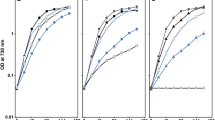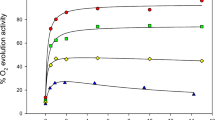Abstract
Photosystem II (PS II) reactions of chloroplast particles show the same variations during the synchronous life cycle of Scenedesmus obliquus, strain D3 (Gaffron Biol. Zbl. 59, 302 1939), as the whole cells they derived from. Photosystem I (PS I) reactions of whole cells and of subchloroplast particles show little or no variation in their activity, whereas PS I reactions of chloroplast particles vary like PS II reactions during the life cycle. The variation in chloroplast particles could be attributed to the change in the reoxidation capacity of plastoquinone still attached to PS I. Digitonin-treatment of chloroplast particles from Scenedesmus and subsequent sucrose density gradient separation yielded 3 distinct fractions: Fraction I contained pure PS I particles with the most efficient PS I-mediated methylviologen (MV) reduction with subsequent oxygen uptake (3 mmol O2/mg Chl·h); no Hill reaction; and a high chlorophyll a/b ratio, and a vast amount of unbound protein xanthophyll complexes. Fraction II is enriched in PS II particles, with little PS I activity (less than 10% of the PS I particles) and a low chlorophyll a/b ratio. The activity of the water-splitting system was completely lost. This fraction must also contain most of the light-harvesting pigment system. Fraction III is also enriched in PS II with even less PS I activity, but the ratio of chlorophyll a/b is slightly higher than in whole cells and the water-splitting system is intact. β-carotene was part of all fractions whereas functional xanthophylls seemed to be restricted to the PS II particles. From the constant chlorophyll P/700 ratio we had to conclude that size of the photosynthetic unit does not change during the life cycle of a synchronized Scenedesmus obliquus culture.
Similar content being viewed by others
Abbreviations
- DBMIB:
-
2,5-dibromo-3-methyl-6-isopropyl-p-benzoquinone
- DCMU:
-
3-(3′,4′-dichlorophenyl)-1,1-dimethyl-urea
- DCPIP:
-
dichlorphenolindophenol
- MV:
-
methylviologen (paraquat)
- PS I:
-
photosystem I
- PS II:
-
photosystem II
- DPC:
-
diphenyl-carbazide
References
Bar-Nun, S., Ohad, J.: Cytoplasmic and chloroplastic origin of chloroplast membrane proteins associated with PS II and PS I active centers in Chlamydomonas reinhardii. Proc. Int. Congr. Photosynth. 3, 1627–1638 (1975)
Bishop, N.I.: The influence of the herbicide, DCMU, on the oxygen evolving system of photosynthesis. Biochim. Biophys. Acta 27, 205–206
Bishop, N.I., Senger, H.: Preparation and photosynthetic properties of synchronous cultures of Scenedesmus. In: Methods in Enzymology. San Pietro, A., ed. Vol. 23A, 53–66. New York: Academic Press 1971
Boardman, N.K., Anderson, J.M.: Isolation from spinach chloroplasts of particles containing different proportions of chlorophyll a and chlorophyll b and their possible role in the light reactions of photosynthesis. Nature 203, 166–167 (1964)
Boardman, N.K., Anderson, J.M.: Fraction of the photochemical systems of photosynthesis II. Cytochrome and carotenoid contents of particles isolated from spinach chloroplasts. Biochim. Biophys. Acta 143, 187–203 (1967)
Böhme, H., Reimer, S., Trebst, A.: The effect of dibromothymoquinone, an antagonist of plastoquinone on non-cyclic and cyclic electron flow-systems in isolated chloroplasts. Z. Naturforsch. 26b, 341–352 (1971)
Butler, W.L.: Energy distribution in the photosynthetic apparatus of plants. In: Chlorophyll-Proteins, Reaction Centers and Photosynthetic Membranes, Brookhaven Symp. Biol.: 28, 338–346 (1976)
Gaffron, H.: Über auffallende Unterschiede in der Physiologie nahe verwandter Algenstämme, nebst Bemerkungen über Lichtatmung. Biol. Zbl. 59, 302–312 (1939)
Grimme, L.H.: Die Carotinoid-Zusammensetzung von PS I und PS II Chlorella-Subchloroplastenpartikeln. Ber. dtsch. Bot. Ges. 87, 509–514 (1974)
Hager, A., Meyer-Bertenrath, T.: Die Isolierung und quantitative Bestimmung der Carotinoide and Chlorophylle von Blättern, Algen und isolierten Chloroplasten mit Hilfe dünnschichtchromatographischer Methoden. Planta 69: 198 (1966)
Hesse, M., Bley, P., Böger, P.: Photosynthetischer Elektronentransport der Alge Bumilleriopsis während der Zellentwicklung. Planta 132, 53–59 (1976)
Hesse, M., Kulandaivelu, G., Böger, P.: Characterisation of synchronized cultures of Bumilleriopsis filiformis, Vischer: Changes in cytochrome-f photooxidation and fluorescence induction kinetics. Arch. Microbiol. 112, 141–145 (1977)
Ke, B., Sahu, S., Shaw, W., Beinert, H.: Further characterisation of a photosystem II particle isolated from spinach chloroplasts by triton treatment. The reaction-center components. Biochim. Biophys. Acta 347, 36–48 (1974)
MacKinney, G.: Criteria for purity of chlorophyll preparations. J. Biol. Chem. 132, 91–109 (1940)
Kuhl, A., Lorenzen, H.: Handling and culturing of Chlorella. In: Methods of Cell Physiol. Prescott, D.M., ed. p. 159. Vol. II. New York, London: Academic Press (1964)
Metzner, H., Rau, H., Senger, H.: Untersuchungen zur Synchronisierbarkeit einzelner Pigmentmangel-Mutanten von Chlorella. Planta 65, 186–194 (1965)
Myers, J., Graham, J.: Photosynthetic unit size during the synchronous life cycle of Scenedesmus. Plant Physiol. 55, 686–688 (1975)
Nelle, R., Tischner, R., Harnischfeger, G., Lorenzen, H.: Correlation between pigment systems and photosynthetic activity during the developmental cycle of Chlorella. Biochem. Physiol. Pflanzen 167, 463–472 (1975)
Schor, S., Siekevitz, P., Palade, G.E.: Cyclic changes in the thylakoid membranes of synchronized Chlamydomonas reinhardii. Proc. Natl. Acad. Sci. USA 66, 174–180 (1970)
Senger, H.: Charakterisierung einer Synchroukultur von Scenedesmus obliquus, ihrer potentiellen Photosyntheseleistung und des Photosynthese-Quotienten während des Entwicklungszyklus. Planta 90, 243–266 (1970a)
Senger, H.: de+Quantenausbeute und unterschiedliches Verhalten der beiden Photosysteme des Photosyntheseapparates während des Entwicklungsablaufes von Scenedesmus obliquus in Synchronkulturen. Planta 92, 327–346 (1970b)
Senger, H.: Changes in photosynthetic activities in synchronous cultures of Scenedesmus, Chlorella and Chlamydomonas. In: Les Cycles Cellulaires et leurs Blocages. Publ. C.N.R.S./Gif No 240, 101–108 (1974)
Senger, H.: Preparation and photosynthetic properties of synchronous cultures of Chlamydomonas. In: Methods in Enzymology, San Pietro, A., ed. New York: Academic Press 1978
Senger, H., Bishop, N.I.: Changes in the quantum yield and photoreduction during the synchronous life cycle of Scenedesmus obliquus. Nature 214, 140–142 (1967)
Senger, H., Bishop, N.I.: Light-dependent formation of nucleic acids and its relation to the induction of synchronous cell division in Chlorella. In: The Cell Cycle, Gene-Enzyme Interaction. Padilla, Whitson, Cameron, Eds. pp. 179–202. New York: Academic Press (1969)
Senger, H., Bishop N.I.: Changes in fluoresence and absorbance during synchronous growth of Scenedesmus. Proc. 2nd Internatl. Congr. on Photosynthesis Research, Stresa 1971. Forti, G., Avron, M., Melandri, A., ed. Vol. 1, pp. 678–687. The Hague: Dr. W. Junk. Publ. 1972
Senger, H., Frickel-Faulstich, B.: The regulation of electron flow in synchronized cultures of green algae. 3rd Intern. Congr. on Photosynthesis, Rehovot 1974. pp. 715–727. Avron, M. ed. Amsterdam: Elsevier Publ. Co. 1974
Senger, H., Mell, V.: Preparation of photosynthetically active particles from synchronized cultures of unicellular algae. Methods in Cell Biology, 15, 201–219 (1977)
Senger, H., Pfau, J., Werthmüller, K.: Continuous cultivation of homocontinuous and synchronized microalgae. In: Methods in Cell Physiology Prescott, D.M., ed. Vol. V. pp. 301–323. New York: Academic Press 1972
Strotmann, H., v. Gösseln, Ch.: Photosystem I-abhängige Photophosphorylierung isolerter Chloroplasten mit Ascorbat/2,6-dichlorphenolindophenol als Elektronendonator und Methylviologen als Elektronenakzeptor. Z. Naturforsch. 27b, 445–455 (1972)
Thornber, J.-P.: Chlorophyll-proteins: light-harvesting and reaction center components of plants. Ann. Rev. Plant Physiol. 26, 127–158 (1975)
Trosper, T., Allen, F.C.: Carotenoid composition of spinach chloroplasts grana and stroma. Plant Physiol. 51, 584–585 (1973)
Vernon, L.P., Shaw, R.R., Ogawa, T., Raveed, P.: Structure of photosystem I and photosystem II of plant chloroplasts. Photochem. Photobiol. 14, 343 (1971)
Wessels, J.S.C., Van Alphen-Van-Waveren, O., Voorn, G.: Isolation and properties of particles containing the reaction center complex of photosystem II from spinach chloroplasts. Biochim. Biophys. Acta 292, 741–752 (1973)
Author information
Authors and Affiliations
Rights and permissions
About this article
Cite this article
Mell, V., Senger, H. Photochemical activities, pigment distribution and photosynthetic unit size of subchloroplast particles isolated from synchronized cells of Scenedesmus obliquus . Planta 143, 315–322 (1978). https://doi.org/10.1007/BF00392004
Received:
Accepted:
Issue Date:
DOI: https://doi.org/10.1007/BF00392004




